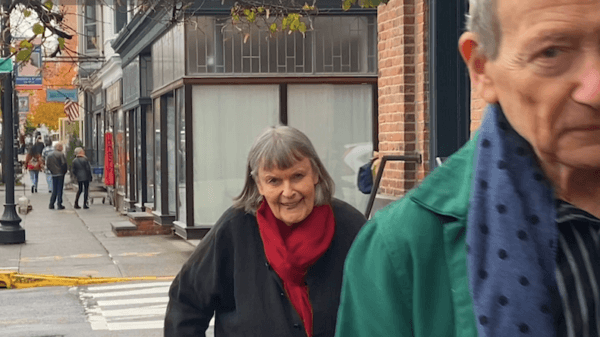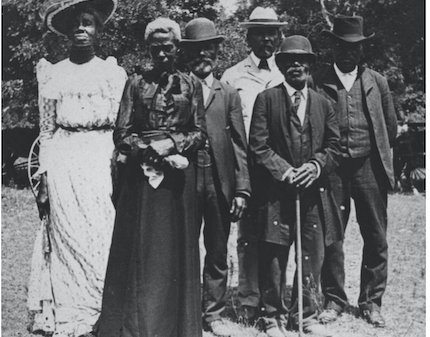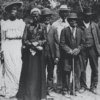Nyack’s Union Hall, an Italianate building predating the Civil War, stood for 83 years as a silent witness to the evolution of a community. Located on Main Street just west of Broadway, this three-story wooden edifice was more than just a building; it was a vibrant tapestry of Nyack’s past, encapsulating a rich history that spanned decades.
Union Hall’s Genesis & Vision
In the spring of 1853, the construction of Union Hall commenced under the watchful eye of local entrepreneur Richard P. Eels. The wooden structure, including a bracketed cornice, parapet railing, and porches, covered two lots. It was a large structure for its time, housing not only two retail shops on the ground floor but also a spacious hall on the second floor. This visionary building seamlessly integrated a mini-mall, church, factory, convention center, proto-village hall, and entertainment complex, reflecting the multifaceted needs of Nyack’s burgeoning community.

Richard P. Eels – A Local Luminary
Richard P. Eels, a native of Lenox MA, arrived in Nyack around 1850, bringing with him a dynamic spirit of entrepreneurship. Initiating his journey with a tinware and stove business on North Broadway, Eels later ventured into real estate, leaving an indelible mark on Nyack’s landscape. At one time, along with Richard DeCantillon he owned the property upon which Hopper’s maternal family built the family home. Despite facing challenges, his involvement in the Rockland County Journal and the Rockland County Savings Bank underscored his commitment to community development.

Eels’ Trials & Triumphs
The year 1878 marked a challenging period for Eels as the Rockland County Savings Bank faced adversity. Indicted and acquitted for making bad investments, Eels experienced financial setbacks, yet his resilience persisted. The 1880 census, curious in its report of Eels being “sick in prison,” remains an enigmatic chapter in his life. Living alone in an apartment within Union Hall during his later years, Eels concluded a significant chapter in Nyack’s ongoing success.
Union Hall’s Cultural Renaissance
Union Hall opened its doors to the public on August 13, 1853, marking the commencement of a cultural explosion in Nyack. The wooden structure accommodated two retail spaces, with Isaac Dutcher’s Union Clothing Store occupying the larger portion. W. G. Haeselbarth, the owner of Nyack’s first newspaper, the Rockland County Journal, also set up his offices within the western side of the first floor.

The Burr-Austin Shoe Company
The top floor of Union Hall found a unique tenant in the Burr-Austin Shoe Company. Up to this time, shoe sewing was done by hand at local homes. Burr became the first in Nyack to harness the power of a sewing machines. The company, led by Burr, employed 150 people, including 100 women who crafted an impressive 65,000 pairs of shoes annually. The factory’s success not only contributed to Nyack’s economic growth but also highlighted gender wage disparities, with women earning 50% less than their male counterparts.

Entertainment Extravaganza
Union Hall became the epicenter of cultural and entertainment activities. Educational lectures, comic ventriloquist performances, minstrel shows, and photographic exhibitions by daguerreotype artists were among the diverse events that graced the hall. The Nyack Philharmonic, directed by local composer Grenville Wilson, added a musical dimension to the cultural tapestry of Nyack.
In addition to the more serious pursuits of culture, Union Hall hosted walking marathons in the 1880s, akin to dancing and six-day bike marathons. A track of tanbark laid in the hall, allowed walkers to circle the hall for 24 straight hours.
Union Hall’s Influence on Commerce
The immediate success of Union Hall transformed its vicinity into a sought-after address. New businesses mushroomed in its proximity, proudly advertising their proximity to the cultural hub that Union Hall had become.

Union Hall Amidst Political Turmoil
Union Hall found itself at the heart of political discussions as the Republican Party formed, opposing the expansion of slavery. Richard Eels’ strong sympathies aligned with the party’s principles, making the hall a venue for heated meetings during a critical period in American history. Slavery became a central topic when the Kansas-Nebraska Act of 1854 voided the Missouri Compromise that had formerly limited the expansion of slavery. Democrats, and later copperheads, met a short distance away at the York House.
At one rally, a banner attached to Union Hall touting the candidacy of Millard Fillmore for President blew down and with it, the chimney across the street tumbled down. It was but one of the dark omens that presaged the destruction to come.
Civil War Rallies & Celebrations
The onset of the Civil War saw Union Hall playing a crucial role in rallying volunteers. Captain James H. Demarest held a final meeting for Company G, 17th regiment, New York State Volunteers, as they prepared to march to the Nyack steamboat landing. The steamboat Isaac Smith took them onward to New York City. Tragically, Demarest would lose his life the following year at the Battle of Bull Run. The hall continued to host rallies and discussions throughout the war, demonstrating its resilience amid the turbulent times.

Women joined to form the Nyack Society, a branch of the United States Sanitary Commission, a forerunner of the Red Cross. Women shipped clothing, sheets, and bandages to the front. In 1864, according to historian Frank Green, the women held a fundraising fair at Union Hall featuring an old Dutch kitchen and dinner. Hostesses wore Dutch short gowns and petticoats and cooked an old-fashioned Dutch dinner, talked in a Dutch patois, and sang songs in the same language.
Veterans began to return in the early summer of 1865 arriving by steamboat. Cheering villagers escorted the veterans to Union Hall where speeches were made by representatives of both parties. At one veteran rally, General Daniel Uhlmann of Grand View spoke. Uhlmann pushed for the first black brigade in the Union army and later, for the first time, led black troops into battle.
Frederick Douglass Speaks
A pivotal moment in Union Hall’s history occurred on August 3, 1865, when Frederick Douglass delivered a lecture on Abraham and Emancipation. Addressing a large and attentive crowd, Douglass advocated for black suffrage and equality, emphasizing the role of slavery in causing the Civil War. His impactful speech resonated with the audience, making Union Hall a venue for thought-provoking discourse.

New Ventures Generated at Union Hall
In addition to its raucous Civil War meetings, the Union Hall also experienced other first-time social institutions in Nyacks. In 1854, the local Baptist Church organized by Joseph W. Griffith, Edward Hopper’s grandfather, held services in the hall and made plans for their own church, later built at the corner of North Broadway and Fifth Avenue.
Parallel to the human emphasis of unionist, temperance became a political force in America. A local temperance group organized in 1855 with the leading lights of the village taking on executive duties, Aaron Christie, Richard Eels, J. D. Waldron, and Isaac Dutcher.
But the hall’s most significant meeting occurred for the formation of the Rockland Female Institute in 1856 by a group of well-intentioned men led by Samuel Sickles, a human rights proponent and charitable philanthropist. Sickles is today immortalized in the eponymous Sickle Avenue. The meetings in Union Hall resulted in the opening of the college in 1856, a mere 17 years after America’s first female college, Mount Holyoke, opened.
While it never came to fruition in the way it was first envisioned, proponents held meetings led by local businessman Azariah Ross to discuss extending the railroad from Piermont to Haverstraw. They envisioned the track running north of Nyack on the river side of Hook Mountain. Fifteen years later, Nyack became the terminus of the Northern Railroad.
Changing Dynamics & Competing Spaces
As Nyack’s community continued to evolve, Union Hall faced competition from new public spaces. Aaron Christie’s Wigwam, the Smith brothers’ Smithsonian Hall, and William Vorhis’ hall on the east side of Broadway, and the Opera House on Depew Avenue altered the social landscape. These venues, though competitors, contributed to Nyack’s vibrant social scene while lessening the importance of Union Hall.

From Glory to Decline
By 1880, Union Hall underwent transformations, with Richard DeCantillon purchasing the property. The upper floors were converted into apartments, witnessing changes in ownership and purpose. Challenges arose, exemplified by a court case in 1888 highlighting a lack of interior sanitation in the building. With the shoe business moved to new buildings, Union Hall’s upper floors became known as “Union Flats.”
The newspaper moved to a new building on South Broadway. The building itself became an old wooden structure hidden among the growing number of three-story brick buildings on Main and Broadway.
Transition to the 20th Century

In 1919, the eastern section of Union Hall was absorbed by the newly constructed Woolworth’s Five and Ten-Cent Store (now the home of Turiello’s pizza). A fire in April 1936 marked the beginning of the end, and by November of the same year, the final section of Union Hall was razed, concluding an 83-year chapter in Nyack’s history.
Legacy in Ashes
The remnants of Union Hall, once a beacon of community life, faded into history. The Lefkowitz building, standing in its place, became a symbol of change. In the 1950s, it housed the National Shoe Company.

Union Hall’s Enduring Legacy
Though Union Hall may be physically absent, its legacy lives on in the collective memory of Nyack. The laughter and cheers of villagers resonate in the stories told, reminding current generations of a time when Union Hall served as a vital thread in the fabric of community life.
Mike Hays is a 38-year resident of the Nyacks. He worked for McGraw-Hill Education in New York City for many years. Hays serves as President of the Historical Society of the Nyacks, and Vice-President of the Edward Hopper House Museum & Study Center. Married to Bernie Richey, he enjoys cycling and winters in Florida. You can follow him on Instagram as UpperNyackMike.
Editor’s note: This article is sponsored by Sun River Health and Ellis Sotheby’s International Realty. Sun River Health is a network of 43 Federally Qualified Health Centers (FQHCs) providing primary, dental, pediatric, OB-GYN, and behavioral health care to over 245,000 patients annually. Ellis Sotheby’s International Realty is the lower Hudson Valley’s Leader in Luxury. Located in the charming Hudson River village of Nyack, approximately 22 miles from New York City. Our agents are passionate about listing and selling extraordinary properties in the Lower Hudson Valley, including Rockland and Orange Counties, New York.









